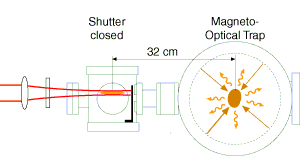A new generation of ‘atom lasers’ could be around the corner following the creation of the first perpetual Bose-Einstein condensate by researchers in the US. Wolfgang Ketterle and colleagues at the Massachusetts Institute of Technology say that their achievement solves the biggest problem in the development of a continuous-wave atom laser. Physicists could probe fundamental properties of matter and light with such devices, which could also be used for applications including atom lithography and atomic clocks (A Chikkatur et al 2002 Science to appear).

(Movie: 71 KB)
A Bose-Einstein condensate is an ultra-cold cloud of gas atoms that are all in the same quantum state, and can therefore be described by the same wavefunction. This ‘atomic coherence’ is analogous to the coherence of the photons emitted by a conventional laser. In recent years, physicists have exploited this phenomenon to make atom lasers that emit atoms with coherent de Broglie waves.
Currently these devices can only emit short bursts of coherent atoms because the condensates get used up very quickly. Although these ‘pulsed’ atom lasers are valuable research tools, a device that could emit a continuous stream of coherent atoms could also be used in a wide range of applications. But longer-lasting condensates are needed to make continuous-beam atom lasers, and these are difficult to make because it is impossible to make a new condensate inside an existing one.
To make a condensate, atoms are ‘evaporatively cooled’ from a temperature of about a hundred millikelvin to about a hundred nanokelvin. If this process were carried out in an existing condensate, the warmer atoms would destroy it. This means that the new condensate must be created elsewhere and then added to the existing one. Until now, it has proved impossible to move and merge condensates in this way.
Now Ketterle and co-workers have overcome this problem by using ‘optical tweezers’ to move a freshly made condensate from a ‘production chamber’ into a ‘science chamber’. Optical tweezers consist of a focused laser that induces an electric dipole moment in the atoms. The atoms are then drawn into the most intense part of the electric field of the laser focus. This allows the atoms to be picked up, moved and then released by switching the laser on, shifting the focus, and switching it off.
Using this technique, Ketterle’s group constantly replenished a condensate so that it contained over a million sodium atoms at all times. They say that adjustments to the experiment should raise this number to a hundred million.
“Our continuous condensate source is the most crucial step towards a continuous atom laser,” team member Ananth Chikkatur told PhysicsWeb. According to Chikkatur, there are already several techniques for extracting the atoms from the condensate into a beam. “In principle, we can do it already,” he says.


